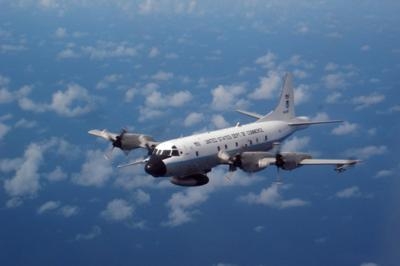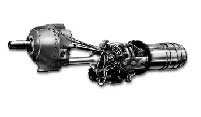Thu, Nov 14, 2013
Fuel-Saving Modifications Developed By Engine Maker Rolls-Royce
The WP-3D "Hurricane Hunter" aircraft of the National Oceanic and Atmospheric Administration (NOAA) will be the first customer to fly with the fuel-saving T56 Series 3.5 engine enhancement package developed by Rolls-Royce. The engine enhancement package has demonstrated nearly 10 per cent reduction in fuel use during recent flight testing in C-130 aircraft, also powered by Rolls-Royce T56 engines. The enhancement allows T56 engines to operate at significantly lower turbine temperatures, extending parts life and improving reliability by 22 per cent.

The two-year, firm-fixed price contract with NOAA covers standard overhauls plus technology insertion in ten engines for two aircraft and spares. Rolls-Royce will contract with Lockheed Martin, manufacturer of the aircraft, to plan and conduct flight testing of the new enhancement packages, as well as complete engine qualification. The first NOAA WP-3D aircraft with the Series 3.5 enhancements are expected to re-enter service beginning in early 2015.
Tom Bell, Rolls-Royce, President Defense, said, "We are thrilled that the NOAA ‘Hurricane Hunters’ will be the first to fly with our T56 Series 3.5 engine enhancement. As NOAA goes about its crucial mission of keeping the public safe and enriching lives through science, we will work to keep their aircraft flying longer, while conserving fuel and lowering maintenance costs."
"Many hurricane missions are into storms far from home base, so fuel-efficiency and engine reliability are critical," said NOAA Corps Cmdr. Devin Brakob, veteran NOAA Hurricane Hunter and aircraft specialist with the NOAA Office of Marine and Aviation Operation’s Platform Acquisition Division. "The anticipated fuel savings and reliability provided by the Series 3.5 engine enhancement package could mean getting an extra pass through the storm instead of heading back to base."

The highly trained men and women from NOAA fly directly into storms in sensor-packed planes to gather data forecasters need to monitor hurricanes and predict their path. NOAA uses two types of aircraft to gather data on hurricanes-the four-engine Lockheed Martin WP-3D Orion turboprop, and a Gulfstream IV-SP jet, powered by two Rolls-Royce Tay engines. The WP-3D flies at low altitudes in the midst of the storm and collects data on wind speed, temperature, and various other storm characteristics. The Gulfstream IV flies above and around a hurricane to observe the winds and weather conditions around the storm.
The Rolls-Royce Series 3.5 engine enhancement package has completed all requirements for US Air Force qualification on the C-130 and recently received FAA certification for the commercial version of the T56 engine. The US Air Force has estimated that incorporating the engine enhancement into its C-130 fleet would save $2 Billion, while extending the life of the fleet for decades.
The T56 Series 3.5 engine enhancement can be installed as part of a conventional engine overhaul, and does not require any aircraft or engine control system modifications. In addition to the US Air Force and NOAA, international operators of C-130 and P-3 aircraft are also considering incorporating the T56 engine enhancement into their fleets.
(Hurricane Hunter image provided by NOAA. T56 engine image provided by Rolls-Royce))
More News
Omnidirectional Approach Lighting System ODALS consists of seven omnidirectional flashing lights located in the approach area of a nonprecision runway. Five lights are located on t>[...]
"Polaris Dawn, the first of the program’s three human spaceflight missions, is targeted to launch to orbit no earlier than summer 2024. During the five-day mission, the crew >[...]
Also: 1800th E-Jet, Uncle Sam Sues For Landing Gear, Embraer Ag Plane, Textron Parts A friend of the family reported that Lt. Col. (Ret.) Richard Glenn Rutan flew west on Friday, M>[...]
Also: Virgin Galactic, B-29 Doc to Allentown, Erickson Fire-Fighters Bought, FAA Reauthorization After dealing with a big letdown after the unexpected decision by Skyreach to disco>[...]
“Our aircrews are trained and capable of rapidly shifting from operational missions to humanitarian roles. We planned to demonstrate how we, and our BORSTAR partners, respond>[...]
 ANN's Daily Aero-Term (05.05.24): Omnidirectional Approach Lighting System
ANN's Daily Aero-Term (05.05.24): Omnidirectional Approach Lighting System Aero-News: Quote of the Day (05.05.24)
Aero-News: Quote of the Day (05.05.24) Airborne 05.06.24: Gone West-Dick Rutan, ICON BK Update, SpaceX EVA Suit
Airborne 05.06.24: Gone West-Dick Rutan, ICON BK Update, SpaceX EVA Suit Airborne 05.03.24: Advanced Powerplant Solutions, PRA Runway Woes, Drone Racing
Airborne 05.03.24: Advanced Powerplant Solutions, PRA Runway Woes, Drone Racing Aero-News: Quote of the Day (05.06xx.24)
Aero-News: Quote of the Day (05.06xx.24)




